|
August 9, 2013 — Atmospheric Acoustic Observatory
|
Updated: 8/21, 8/23, 9/11
[NOTE, 9/10/13 — Check out what
Charles Babbage wrote
about sound and how it endures in the world. As for this report below on
my 'Acoustic Observatory,' I wish I could devise a simple and
low-cost way to record its output; but since I only wish it, obviously
it's not going to happen. This instrument is real-time only; i.e., you just watch
the red spot and see if the bobbing up and down corresponds sounds you can
hear — or to wind; even with a slight breeze, the pressure variations inside
my house make the red spot traverse 5 to 10 cm, corresponding to several Pascals
of air pressure change. (I estimate that a 1-mm motion of the red spot corresponds
to about 3 millipascals of pressure change in the air, but when the wind is
blowing, the spot goes up or down as much as 10 cm total amplitude.) I've
noticed that when I walk across the bedroom where it's located, walking as
silently as I can, the red spot moves in a way that suggests that
deflection of the wood floor is being picked up because of air pressure
changes; however, I can't rule out that motion of the floor is not directly
affecting the instrument through the floor; it's placed near a wall,
where the deformation of the floor should be much less than were it in the
middle of the room. Also, late at night, when I lie in bed watching it and
there's no perceptible air motion, the red spot occasionally moves in ways
to which I cannot assign plausible explanations, sometimes moving slowly up
and down. Who knows what I'm seeing, and how far it might be coming from.
It's as if ghosts are influencing it.]
|
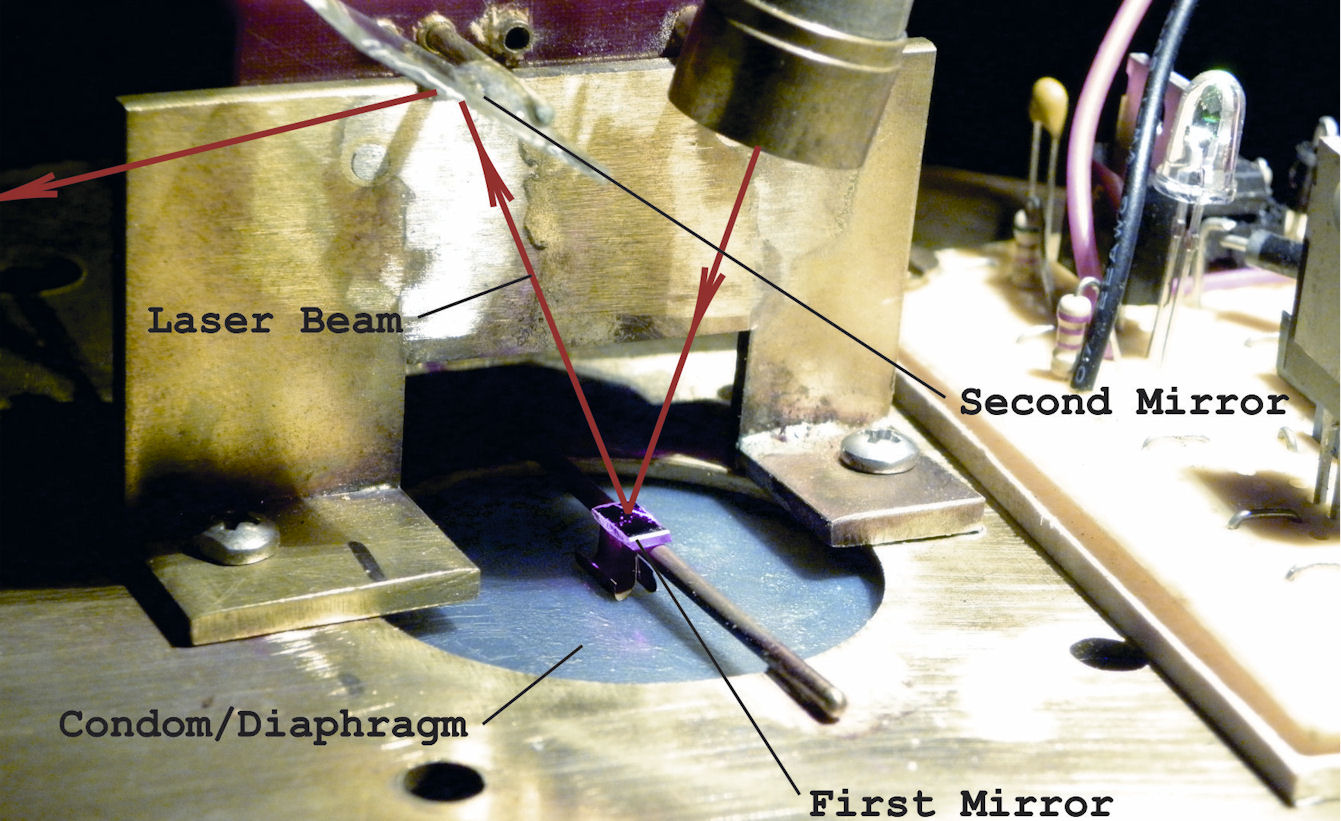
I've built another ViiP since my last posting of June 2. Works good.
This present report describes an experiment I've been wanting to do for several years, and now I've
built it. My goal was to be able to "hear" thunder from storms in central Maryland, i.e., more than
30 miles from where I live in the Maryland suburbs of Washington, D.C. This Atmospheric Acoustic
Observatory seems, in my preliminary tests, much more sensitive than I had expected. Here's some
background:
Everyone knows there are certain "colors" of light that human eyes cannot
see, such as X-rays, ultraviolet, infrared, and radio waves. Special instruments are needed to "see"
those colors of light that are outside of the spectrum of visible light.
Likewise, there are sounds, too, that human ears cannot hear. For instance,
low-frequency sounds as are said to radiate through the air for thousands of miles from earthquakes
and volcanos. Hurricanes, also, generate long wavelength sounds that travel thousands of miles, and
yet cannot be heard directly. (Check out microbaroms,
"the voice of the sea," produced by
storms at sea.)
 For about $50 worth of parts, including a powerful
red laser diode, I built what I am calling an Atmospheric Acoustic Observatory. (Click on the
image for a larger view.) For about $50 worth of parts, including a powerful
red laser diode, I built what I am calling an Atmospheric Acoustic Observatory. (Click on the
image for a larger view.)
It consists of a 5-gallon plastic water bottle with a narrow neck, over which
is stretched a condom, which works as a diaphragm that vibrates when
acoustic waves (i.e., sounds) impinge upon it. The condom (Trojan, model 'Pleasure Ecstasy') is
adequately tight and durable for its diaphragm function.
Here, below, is a schematic overview of the Observatory's operation, showing
how a tiny motion of the diaphragm gets magnified ~2,000 times by the motion of the laser's red dot on
a wall or screen. (I currently have the red dot shining on the ceiling of my bedroom so I can watch
microbarometric oscilations when I can't sleep.)
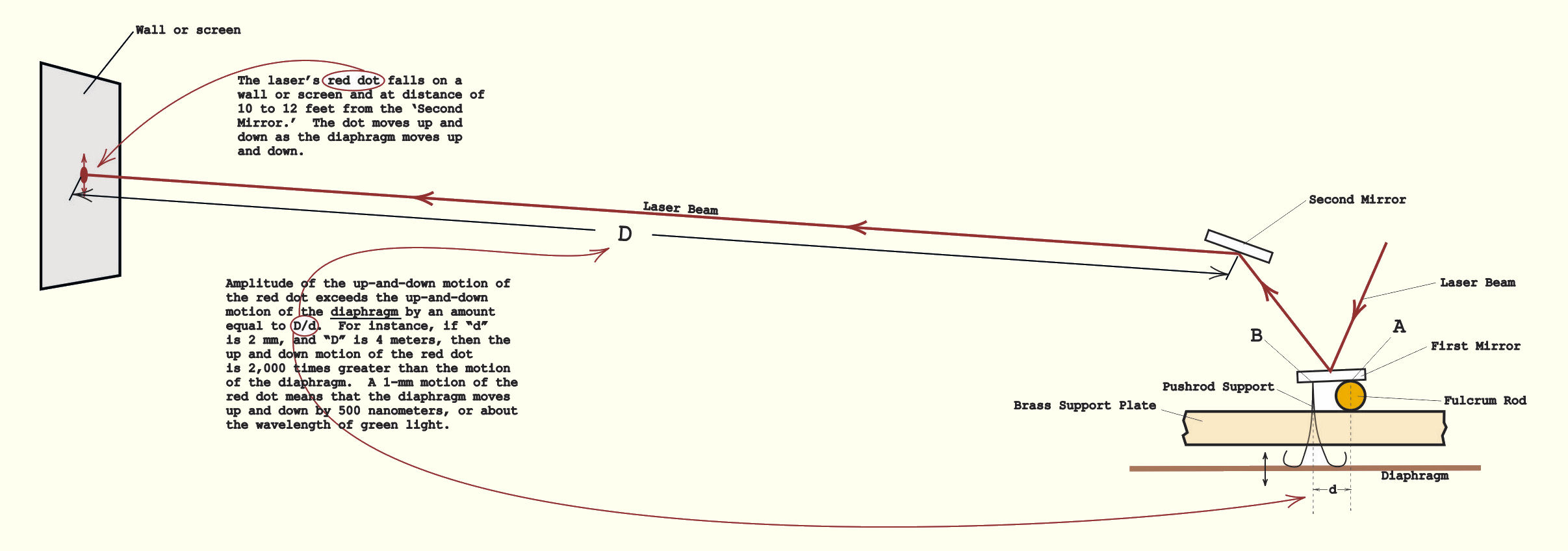
Click on the image below for a larger view of this schematic diagram
of the Acoustic Observatory's operating principle. It's quite simple, and plausibly not novel.
When the diaphragm vibrates, the Pushrod Support causes the First Mirror to move on the Fulcrum Rod.
(The Second Mirror directs the laser beam horizontally toward a distant wall or screen.)
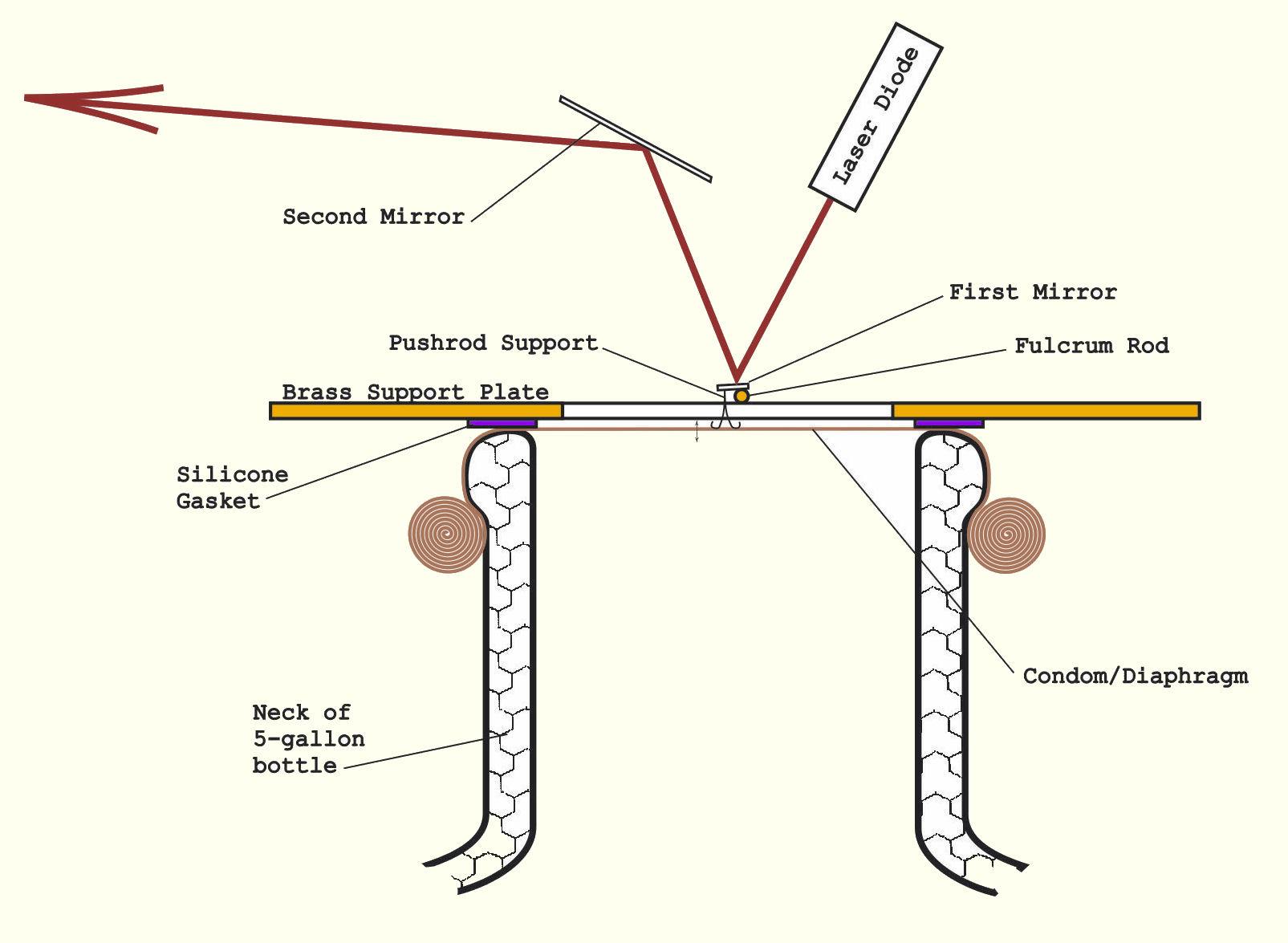
The next diagram is a closer view; When the diaphragm vibrates, the
Pushrod Support causes the First Mirror to rotationally oscillate around point A on the Fulcrum
Rod. The laser beam thus gets deflected when the diaphragm is exposed to acoustic waves,
i.e., noises.
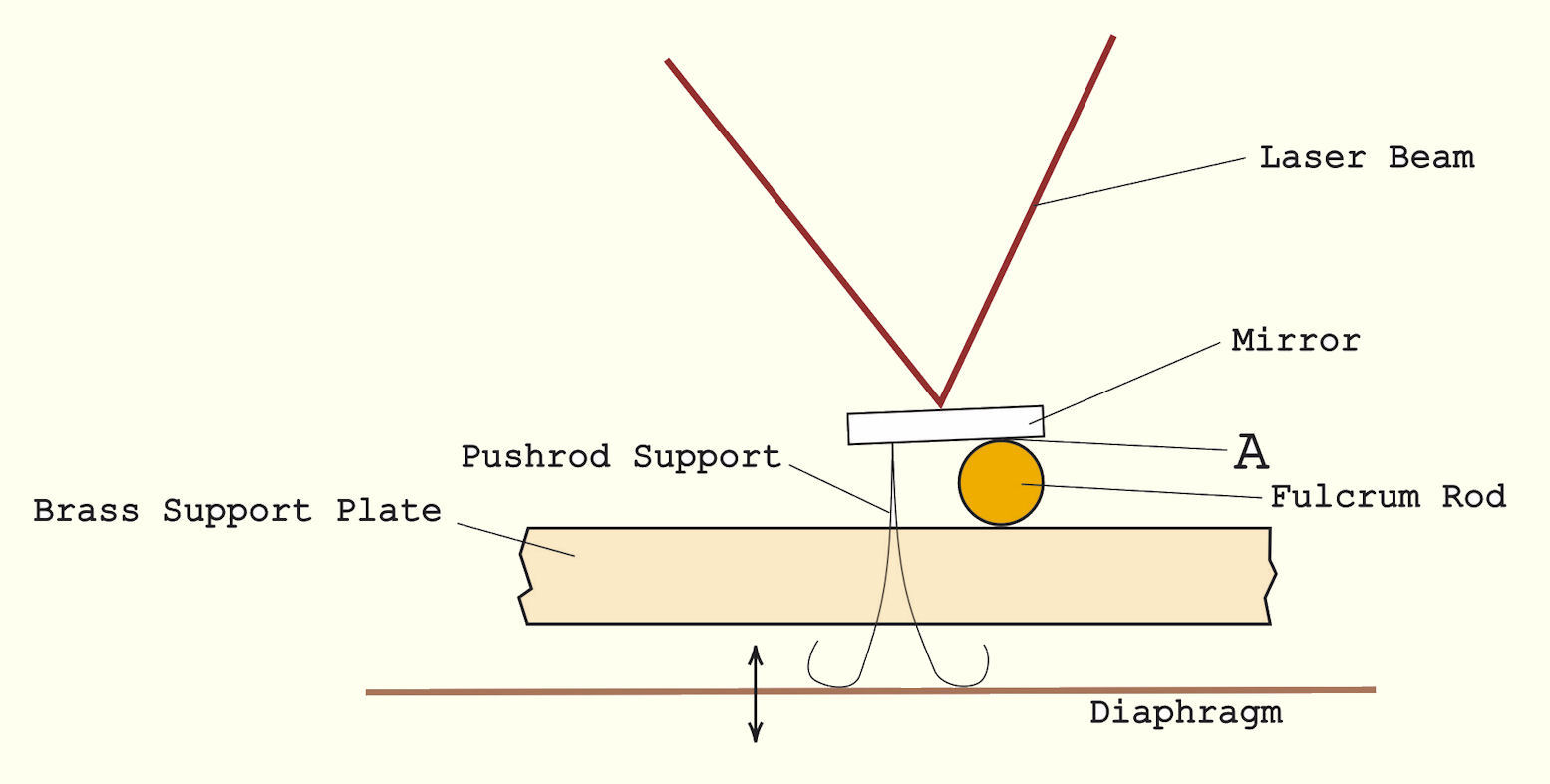
In the next diagram, the distance “d” between point A, where the
First Mirror balances on the Fulcrum Rod, and point B, where the Pushrod Support touches the mirror,
is 2 millimeters. If the reflected laser beam travels, say, 4 meters after the First Mirror reflects
it, then the up-and-down motion of the laser spot (see the video) will
be 2,000 times greater than the vibratory motion of the diaphragm. (A 2-mm motion of the red spot
will correspond to a 1-micron motion of the diaphragm.)
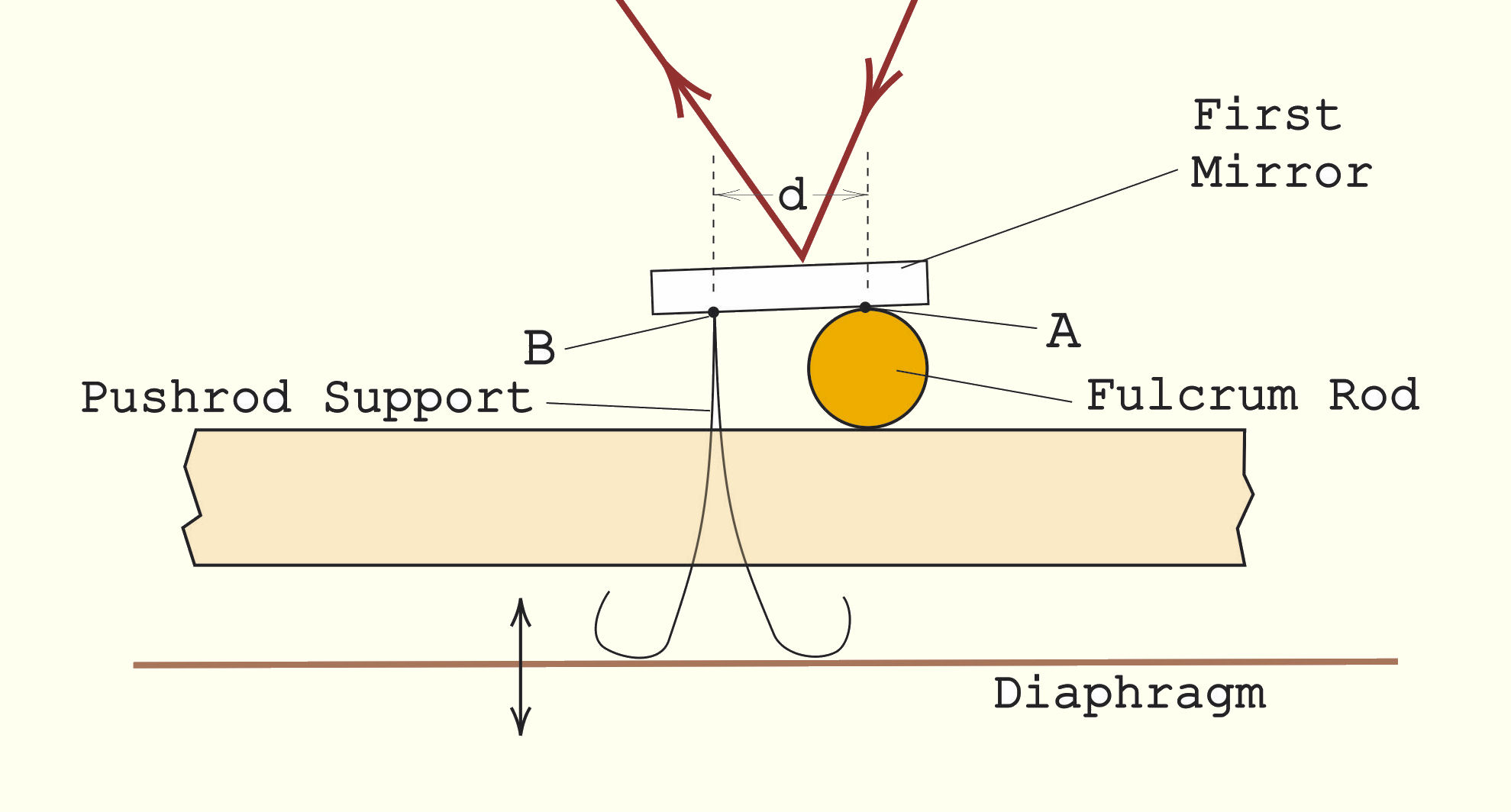
Note in the video that the red spot gradually
drifts downward, which suggests a slow atmospheric pressure INCREASE lasting several seconds. "Suggests"
a pressure decrease, but the downward drift of the spot might actually mean only that the morror (the
"first mirror") is sliding out of its position on the "fulcrum rod"; a better mounting is needed; the
mirror comes unmounted sometimes when the main garage door is opened or closed, which creates a loud
noise.
The video of the moving laser spot should
have the sound of traffic about a hundred yards from my laboratory/garage, but apparently it was too
faint to be recorded. But we can "see" that sound with the moving red spot. This Acoustic Observatory
is so sensitive, that I can clear my throat when I'm three meters from the Observatory's detector — i.e.,
the detector consisting of the 'first mirror,' resting on the 'fulcrum rod' and actuated by the
'pushrod support' — the red spot moves up and down more than half an inch, which, as I calculate it,
corresponds to a pressure level at the condom/diaphram of . . . well, I'll calculate it in the
next day or so . . .
The same laser-and-mirror principle used in
this Acoustic Observatory can be used in a pretty sensitive Seismic Observatory.
I also intend to add some interesting info about this device. For
instance, that a 1-mm movement of the red spot corresponds to a
deflection of the condom/diaphragm that is less than the wavelength of visible light — on the order
of one two-hundredth of an RCH! More to come . . .
Send comments to Bob.
|
|